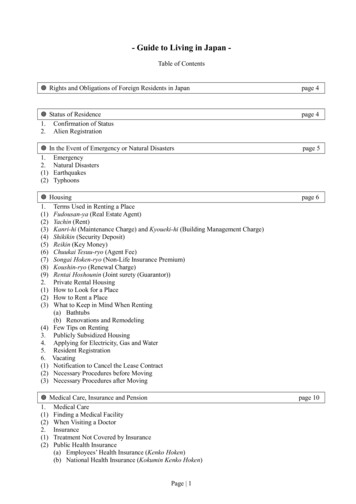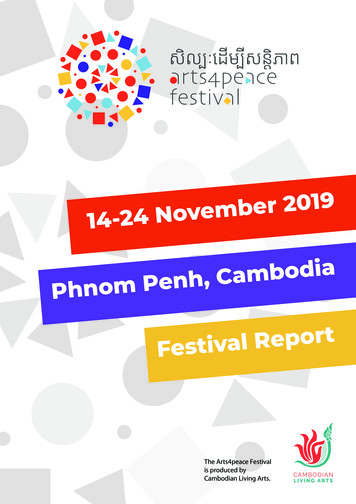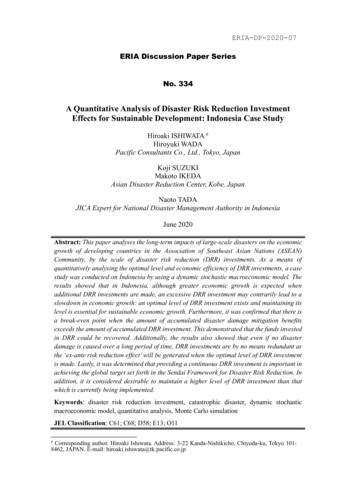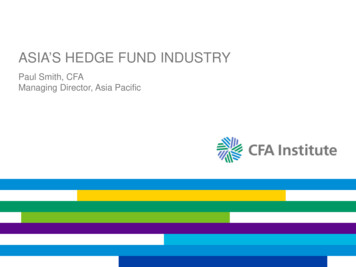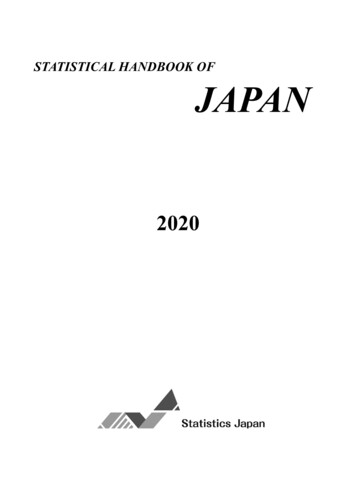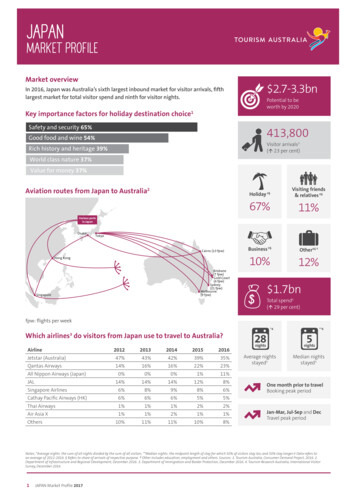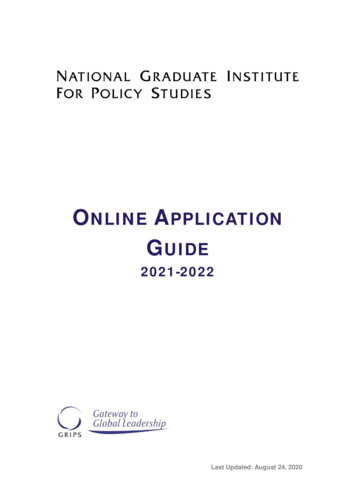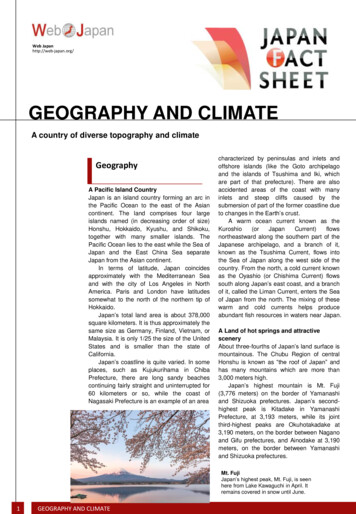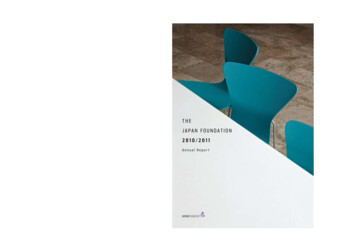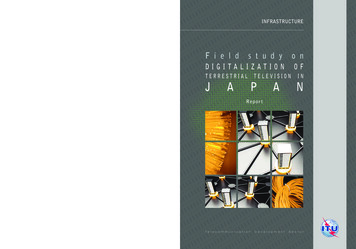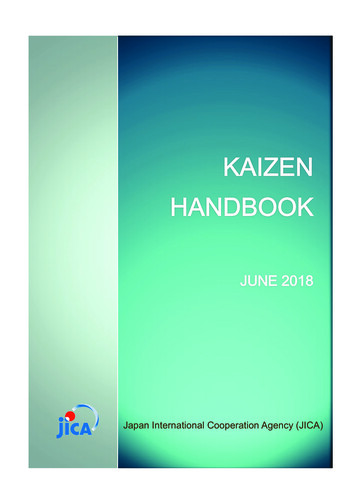
Transcription
Japan International Cooperation Agency (JICA)
Table of ContentsPageTable of Contents . iList of tables & figures . iiiList of Abbreviation . ivDefinition of Kaizen-related Terms . vIntroduction1.1.1Overview of KaizenWhat is Kaizen? . 1-11.1.1 Essence of Kaizen . 1-11.1.2 Need for Application of Kaizen in Africa . 1-31.2Differences in Quality/Productivity Management in Japan and in Europe and the U.S.A. . 1-41.2.1 Development history of quality/productivity improvement in Japan until 1980 . 1-41.2.2 Evolution and modification of Kaizen in Europe and the U.S. since 1980 . 1-61.2.3 Comparison of quality/productivity improvement among Japan, Europe and theU.S.A. . 1-71.3Kaizen and Innovation . 1-81.3.1 Defining Innovation . 1-81.3.2 Relation between Kaizen and Innovation. 1-91.3.3 Firm Capabilities and Kaizen . 1-112.2.1Kaizen Dissemination in AfricaSystem of Kaizen Dissemination . 2-12.1.1 Fundamentals of Policy and System Development for Kaizen Dissemination . 2-12.1.2 Commitment of the Government to Kaizen Dissemination . 2-82.2Points of Kaizen Dissemination by Stages . 2-122.2.1 Key Points during the Introduction Stage of Kaizen Promotion . 2-122.2.2 Key Points during the Dissemination Stage and the Full-Fledged Stage . 2-133.3.1Kaizen-related Human Resource Development SystemQualifications for Kaizen Trainers . 3-13.1.1 Kaizen-related personnel and career path . 3-13.1.2 Requirements for Kaizen Trainers . 3-23.2Standard Program for Kaizen-related Human Resource Development . 3-53.3Course Organization for Classroom Training (CRT) . 3-63.4Classroom Training (CRT) . 3-83.4.1 CRT for Basic Trainers . 3-83.4.2 CRT for Advanced Trainers. 3-9i
3.5In-Company Training (ICT). 3-103.5.1 ICT in the form of Kaizen activity at pilot companies . 3-103.5.2 Selection of pilot companies participating in the ICT . 3-113.5.3 ICT for Basic Trainers . 3-133.5.4 ICT for Advanced Trainers . 3-163.6Management of the Kaizen-related Human Resource Development Program . 3-173.6.1 Planning stage . 3-173.6.2 CRT implementation stage . 3-193.6.3 ICT implementation stage . 3-193.7Capacity Evaluation . 3-203.7.1 Capacity evaluation by written examination . 3-203.7.2 Capacity evaluation by skill map . 3-203.7.3 Recognition of Basic Trainers and Advanced Trainers . 3-213.7.4 Kaizen Consultant certification system . 3-223.7.5 Establishing and managing a certification system . 3-243.8Training of Intra-Firm Human Resources for Kaizen . 3-253.8.1 Training of the top management . 3-253.8.2 Training of Kaizen Leaders . 3-273.9Overseas Training . 3-293.9.1 Types of JICA’s training programs. 3-293.9.2 Key points in effective use of overseas training . 3-303.10 Measurement of Kaizen Effect and Performance Indices . 3-313.10.1 Measurement method . 3-313.10.2 Calculation of economic effect . 3-35AppendicesAppendix 1 Analysis of Country Studies Comparison of Human Resource Development in Each Country List of Training Program Subjects and Textbooks Organization Chart of Kaizen Promotional organizations in each countryAppendix 2 Case Studies on Kaizen Disseminationii
Tables & Figures1.Overview of KaizenTable 1.2-1Figure 1.1-1Figure 1.1-2Figure 1.2-1Figure 1.2-2Figure 1.3-12.Kaizen Dissemination in AfricaTable 2.1-1Figure 2.1-1Figure 2.2-13.Comparison of Approaches between Japan and Europe/the U.S.A. . 1-8Characteristics and Effects of Kaizen. 1-1Kaizen Implementation Process and the PDCA Cycle . 1-2Two Pillar Concepts of the Toyota Production System (TPS) . 1-6Transition of Quality and Productivity Improvement in Japan and the U.S.A. 1-7Function of Innovation . 1-10List of Major Kaizen Promotion Organizations and their Structures in the CountriesStudied . 2-4System of Activities Necessary for Promoting Kaizen . 2-2Verification of Kaizen Dissemination through PDCA Cycle . 2-14Kaizen-related Human Resource Development SystemTable 3.1-1Table 3.1-2Table 3.3-1Table 3.3-2Table 3.4-1Table 3.4-2Table 3.5-1Table 3.7-1Table 3.7-2Table 3.7-3Table 3.8-1Table 3.8-2Table 3.9-1Table 3.10-1Table 3.10-2Table 3.10-3Figure 3.1-1Figure 3.1-2Figure 3.2-1Figure 3.5-1Figure 3.5-2Figure 3.5-3Figure 3.5-4Figure 3.5-5Definitions and Roles of Kaizen Trainers and Kaizen Leaders . 3-2Basic and Specific Capability Required for Kaizen Trainers . 3-3Skills for Basic Trainers . 3-6Skills for Advanced Trainers . 3-7Classroom Training for Kaizen Trainers . 3-9Classroom Training for Advanced Trainers . 3-9Pilot Company Evaluation Sheet (Example) . 3-12Skill Map for Basic Trainers (Example) . 3-21Recognition Requirements for Basic Trainers and Advanced Trainers . 3-22Kaizen consultants Titles and qualification requirements . 3-23Training for the Top Management (Example) . 3-27CRT for Kaizen Leaders (Example) . 3-28JICA’s Training Courses . 3-30Categories of Kaizen Effects . 3-31Activity and Environmental Indices. 3-33Outcome Indices . 3-34Structure of Kaizen Trainers and Kaizen Consultants . 3-1Skills for Kaizen . 3-4Flow of Kaizen Trainer Training . 3-5Flow of the ICT . 3-10Flow of Selection Process of Pilot Enterprise . 3-11Standard Schedule of Basic Trainer Training . 3-14Activities of Basic Trainers in the Implementation of Kaizen . 3-15Standard Schedule for Advanced Trainer Training . 3-17iii
List of AbbreviationAFDAgence Française de Développement/ French Development AgencyAPME (Cameroon)Agence de Promotion des Petites et Moyennes Entreprises/ Agency for Small and Medium-BDSBusiness Development ServiceC/PCounterpartCETIME (Tunisia)Centre Technique des Industries Mécaniques et Électriques / Technical Center for Mechanicalsized Enterprises Promotionand Electrical IndustriesCRTClass Room TrainingEKI (Ethiopia)Ethiopia KAIZEN InstituteGIZDeutsche Gesellschaft für Internationale Zusammenarbeit / German Corporation forInternational CooperationGTP2 (Ethiopia)Growth and Transformation Plan IIHRDHuman Resource DevelopmentICTIn Company TrainingIEIndustrial EngineeringINTI (Argentina)Instituto Nacional de Tecnologia Industrial / National Institute of Industrial TechnologyJISJapanese Industrial StandardsJITJust In TimeJPCJapan Productivity CenterJUSEUnion of Japanese Scientists and EngineersKIBT (Kenya)Kenya Institute of Business TrainingKIZ (Zambia)KAIZEN Institute of Zambia LimitedMPC (Malaysia)Malaysian Productivity CorporationMPSHRD (Ethiopia)Ministry of Public Service and Human Resource DevelopmentNBSSI (Ghana)National Board for Small Scale IndustriesNPB (Singapore)National Productivity BoardNEPADNew Partnership for Africa's DevelopmentOJTOn the Job TrainingQCQuality ControlQCCQuality Control CircleQCDQuality/Cost/DeliverySMEDSingle Minute Exchange of DieSQCStatistical Quality ControlSWOTStrengths, Weaknesses, Opportunities, and ThreatsTICADTokyo International Conference on African DevelopmentToTTraining of TrainersTPMTotal Productive MaintenanceTPSToyota Production SystemTQCTotal Quality ControlTQMTotal Quality ManagementTVETTechnical and Vocational Education and TrainingUGPQ(Tunisia)Unité de Gestion du Programme National de Promotion de la Qualité en Tunisie/ ManagementUnit for the National Quality Promotion Program in Tunisiaiv
Definition of Kaizen-related TermsVarious Kaizen terms that have been used under different names in previous JICA projects,including personnel relating to Kaizen dissemination, names of training programs relating tohuman resource development, and personnel who has completed various training programs, aredefined in this handbook as follows.KaizenThe core value of Kaizen is placed in creating the attitude shared among all members of anorganization who consistently pursue advanced levels of quality and productivity, and not justapplying its management method. Kaizen is a comprehensive knowledge that consists of broadtechnologies such as 5S, 7 QC tools, TQM, TPS, Lean Production System, etc. to pursueactivities under this core value.Note: Japan Industrial Standard (JIS) defines “KAIZEN (JIS8141, No.1110) as a productionmanagement term as follows:“An activity conducted by a small group or a small number of persons to review anoverall management system or its part and to improve capacity and other capabilities”The English name is KAIZEN or continuous improvement.Kaizen ActivityAn activity using Kaizen techniques and systems to improve the present work styles, methods orconditions and to upgrade quality levels of products, service or operations to a desirablecondition.Kaizen ConsultantA person who has been accepted by a Kaizen-related licensing or certification system as a KaizenConsultant. Kaizen Consultants are divided into three categories, namely Kaizen Consultants,Senior Kaizen Consultants, and Principal Kaizen Consultants.Kaizen TrainerA person who gives guidance on Kaizen activities to companies and other organizations. Theyare classified into Basic Kaizen Trainers and Advanced Kaizen Trainers. To become a KaizenConsultant, it is necessary to have capacity and skills required of Advanced Kaizen Trainers.Advanced Kaizen TrainerA person who has obtained skills on both Basic Kaizen and Advanced Kaizen by receivingtraining specifically designed to train Kaizen Trainers, which is conducted under the guidance ofexperts or senior Advanced Kaizen Trainers, or by receiving other training equivalent to it.v
Advanced Kaizen Trainers are responsible for provision of Kaizen guidance and service (trainingand consulting) for private companies and other organizations and training of junior KaizenTrainers (both Basic Kaizen Trainers and Advanced Kaizen Trainers).Basic Kaizen TrainerA person who has obtained skills on Basic Kaizen by receiving training specifically designed totrain Basic Kaizen Trainers, which is conducted under the guidance of experts or AdvancedKaizen Trainers. He/she provides companies and other organizations with training andconsulting service on Basic Kaizen.Kaizen LeaderA person who has received Kaizen Leader training from experts, Advanced Kaizen Trainers orBasic Kaizen Trainers prior to the start of Kaizen activities within the organization he/shebelongs to. He/she is responsible for administration and promotion of Kaizen activities in it.He/she has skills and experience on Kaizen, which are equivalent to those of Basic KaizenTrainers.Kaizen TrainerQualified Kaizen ConsultantCareer Path for Kaizen-related Human ResourcePrincipal KaizenConsultantSenior KaizenConsultantKaizen ConsultantIn addition to experience as a senior consultant,person who has organization management /management abilities.Person who is qualified as Kaizen Consultant meetsother certification criteria.Person who meets the certification criteria underthe Kaizen consultant qualification certificationsystem.Advanced Kaizen Trainer(Advanced Trainer)Person who completed both Basic Kaizen course andAdvanced Kaizen course.Basic Kaizen Trainer(Basic Trainer)Person who completed Basic Kaizen courseKaizen LeaderPerson who completed Kaizen leader course, managesand controls in-house Kaizen activities.Source: JICA Study TeamStructure of Kaizen Trainers and Kaizen ConsultantsClass Room Training (CRT)A general term for training programs, centered on lecture, designed for candidate KaizenTrainers.vi
In Company Training (ICT)A general term for training programs for candidate Kaizen Trainers in which they actuallyprovide Kaizen guidance with companies and/or other organizations and thereby learn practicalKaizen skills.Basic KaizenKaizen activities which are basic and need to be implemented regardless of business types orcapacity levels, such as 5S, Visual Control, and Muda-dori. It is Kaizen at the elementary level,which is implemented regardless of company sizes and also easy to take effect in a short period.CRT and ICT for Basic Kaizen Trainers cover a range of subjects required for these activities(both knowledge and skills).Advanced KaizenKaizen activities which apply engineering techniques to deal with specific problems such asproductivity improvement, reduction of a defect rate, and cost reduction. It applies statisticalmanagement and counting management methods. CRT and ICT for Advanced Kaizen Trainerscover a range of subjects required for these activities (both knowledge and skills).Base LineQuantitative values representing conditions prior to the start of Kaizen activities (e.g. 10% defectratio). Kaizen result is measured by comparison with the baseline. It has the same meaning asconditions before Kaizen of the before-after analysis.Lean Production SystemProduction management techniques restructured and generalized based on the Toyota ProductionSystem, with an aim to reduce the total cost of the whole production system by eliminating wastein the production process.Six SigmaQuality management techniques to identify a cause for a problem relating to a product or aproduction process and thereby to implement corrective measures by analyzing a production andother process using statistical analysis and quality management techniques in a systematicmanner to reduce defect rates, improve customer satisfaction, etc. As the action process for SixSigma, the MAIC (measurement, analysis, improvement, and control) cycle, as evolved from thePDCA cycle used in QC activity, is repeated continuously.ISO18404An international standard on management improvement techniques as established and announcedby ISO in 2011. It sets certification requirements for “Six Sigma” and related “Green Belt(GB)/Black Belt (BB)/Master Black Belt (MBB) as ISO 18404 (Quantitative Techniques forvii
Process Improvement – Six Sigma – Capacity of Key Personnel and Organization’s Suitabilityfor Implementation of Six Sigma and Lean Production).Business Development Service: BDSA general term for various services, except for financial support, to encourage and promote entry,growth and survival in a market by microenterprises and SMEs, and improvement of theirproductivity and competitiveness.viii
IntroductionJapan International Cooperation Agency (JICA) has been providing support for Kaizenprojects in industrial sectors in around 30 countries so far. As for African countries,Kaizen-related technical cooperation projects have been carried out in 8 countries since the firstproject in Tunisia was implemented in 2006. Naturally, these projects have been generatingdifferent results and impacts among the countries. Various lessons were learned: such as the needto ensure commitment of high level government officials, the need to establish and maintain astrong Kaizen promotion organization and system, and standardization of an approach to securequality of Kaizen promotion personnel. To further accelerate industrial development throughdissemination of Kaizen in the African continent, JICA in collaboration with NEPAD (NewPartnership for African Development) Agency launched “Africa KAIZEN Initiative”.As part of these efforts, a JICA research project, “Standardizing KAIZEN Approaches inAfrica", is conducted from April 2017 to June 2018. The research project is designed to ensure amore effective dissemination of Kaizen in Africa, by synthesizing and analyzing experiencesaccumulated in various countries where Kaizen projects were conducted, particularly in an attemptto establish specific processes and procedures for the implementation of the initiative and tostandardize Kaizen approaches and curriculums for the development of human resourcesresponsible for Kaizen dissemination. This handbook is intended to be used by policymakers ofcountries that are disseminating or have an intention to disseminate Kaizen. Practitioners actuallyengaged in Kaizen promotion are also one of the targets. It principally covers industrial sectorsand presents curriculums, syllabus, and textbook lists for developing Kaizen-related humanresources, and actual dissemination approaches and methods. The handbook also containssummaries of key success factors and lessons learned from different case studies.Various Kaizen techniques introduced in this handbook are based on those created andmodified through efforts and ingenuity of forerunners who have persistently been working in thearea. Also, a variety of approaches to Kaizen dissemination proposed in the handbook are on thebasis of activities of JICA projects conducted with a process of trial and error and with dueconsiderations to social and cultural differences in each country as well as differences in industrialstructure. Naturally, it must be admitted that there might be some lack of understanding on theknowledge and experiences within the Study Team, i.e., the handbook may not fully explain a trueintent on and meaning of Kaizen dissemination, which is to be corrected or improved upon thereader’s feedback.We hope that this handbook will be widely used and thus contribute to Kaizen disseminationin many countries, and then further contribute to the economic development agenda of thecontinent.Finally, we would like to express our gratitude to all institutions and persons who havecooperated in the preparation of this handbook.JICA Study Team (UNICO/JPC) for Research Studyon Standardizing KAIZEN Approaches in Africa
1. Overview of Kaizen1. Overview of Kaizen1.1 What is Kaizen?1.1.1 Essence of KaizenThe word “Kaizen” as a general term for “techniques and tools for improvement of qualityand productivity” was first used in the Japanese manufacturing industry, but is now recognizedworldwide. However, people have different views and perspectives on the understanding and thescope. In this handbook, the core value of “Kaizen” is placed in creating the attitude sharedamong all members of an organization who consistently pursue advanced levels of quality andproductivity, and not just applying its management method. Hence, Kaizen is a comprehensiveknowledge that consists of broad technologies such as 5S, 7 QC tools, TQM, TPS, LeanProduction System, etc. to pursue activities under this core value.Participatorytarticipation from topmanagement all the waydown to front line workers isessential. Suggestions fromworkers are encouraged.UniversalContinuousApplicable in any country,industry, sector, size andorganization.Activities consisting of smallbut continuous efforts on adaily basis add up resultingin big changes.EconomicalScientific ApproachEmphasis is on using wisdommore than money.Applicable even when thereare resource limitations.Source:Rational measures based onstatistical data analysis.Improves quality, productivityand service level;Reduces cost and delivery timeChanges mindsets of managersand workersCosters personnel who can thinkand act by themselvesBuilds teamwork and enhancescommunicationCreates a strong organization thatkeeps evolving and developingCreates a safe and comfortablework environmentAdapted by the JICA Study Team from a JICA’s brochure “KAIZEN Management approach for enhancingquality and productivity: the driving force for economic development”Figure 1.1-1 Characteristics and Effects of Kaizen1-1
1. Overview of KaizenA question then arises as to what could be the benefits of implementing Kaizen? Fig. 1.1-1summarizes major characteristics and effects of Kaizen. Among the five characteristics listed, thefirst one “participatory” indicates promotion and encouragement of participation by every memberof an organization. The second one “continuous” emphasis on accumulation of daily activities,which leads to big results. The third one is “scientific approach” based on statistical data. Thefourth one “economical” indicates placement of value on using brain to create much more ideasrather than spending money (making an investment), and the fifth one “universal” indicates itsbroad applicability: it uses easy-to-use tools and thus allows anyone to implement it, withoutspecial technology or equipment, in any field, organization or size.The fundamental of Kaizen is to repeat Plan-Do-Check-Act (PDCA) cycles (see Fig. 1.1-2).Along with repeating of the PDCA cycle, everyone in the organization acquires mind and attitudeto pursue a high level of quality and productivity constantly, which leads to improvement of ownwork quality and improvement of QCD (Quality/Cost/Delivery).Kaizen of Quality of WorkRealization of QCD(Quality, Cost, Delivery)Continuous ActivitiesSource: JICA Study TeamFigure 1.1-2Kaizen Implementation Process and the PDCA CycleContinuing Kaizen activities with these characteristics brings about the effects presented inFig. 1.1-1. With a strong inclination toward human resource development, Kaizen enablesimplementing organizations to develop discipline, engagement, and teamwork of individuals and1ultimately strengthen “firm capabilities” as well as to improve quality and productivity of goodsand service.For instance, Ethiopia KAIZEN Institute (EKI), which has been conducting training ofKaizen practitioners and institutional development for Kaizen dissemination under JICA’s support,estimates the cumulative economic effect produced at companies, mainly manufacturers, duringthe five-year period since 2011 at more than 100 million. In the same period, the government’s1Firm capabilities are a source of company growth, referring to overall capacity and skills an individual company possesses.1-2
1. Overview of KaizenEKI-related budget was as little as 4.13 million, and the total expenses including JICA’s support2around 10 million .This indicates that Kaizen promotion is a cost-effective policy measure.At the same time, as already explained, Kaizen drives change in people’s mindset and thusfunctions as a means to develop core capacity of the people as well as functions as an instrumentof industrial policy. Although it is difficult to show benefits of such change in the short term, itis actually important for country’s growth in the long term.This approach of Kaizen was transferred from Japan to Asian countries, such as Singaporeand Malaysia, in the 1980s, and also to Western countries. And now each country has developedit in their own way.1.1.2 Need for Application of Kaizen in AfricaKey issues of the manufacturing industry commonly seen in Africa, especially in theSub-Saharan region, are summarized as follows. The manufacturing industry’s GDP share is fairly small, with low productivity.The manufacturing industry has a low job creation rate while high unemployment is prevalent,especially in young generations. The manufacturing industry consists of a small number of mid-sized and large enterprises anda large number of micro enterprises and small enterprises. Educational background of most of company employees is limited to primary education or less,barely qualified for working at modern industrial facilities. Traditional and non-modern business/labor management system and practice still remains.These are common problems in Africa, but some companies have already overcome theseproblems and adopted a modernized business/labor management system and practice. However,3issues listed above are true at the national level for almost all African countries, if not all .Developing medium- and high-tech sub-sectors and increasing value added of the industry as awhole are also challenges for African countries, although the manufacturing industry in Africarecords steady growth in recent years
Kaizen Trainers). Basic Kaizen Trainer . A person who has obtained skills on Basic Kaizen by receiving training specifically designed to train Basic Kaizen Trainers, which is conductedunder the guidance of experts or Advanced Kaizen Trainers. He/she provides companies and other organizations training and with consulting service on Basic Kaizen .

